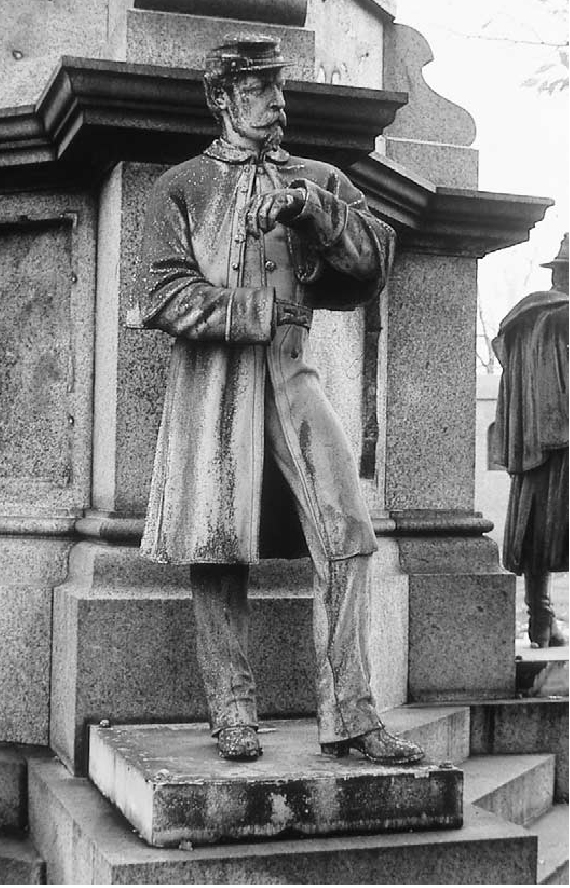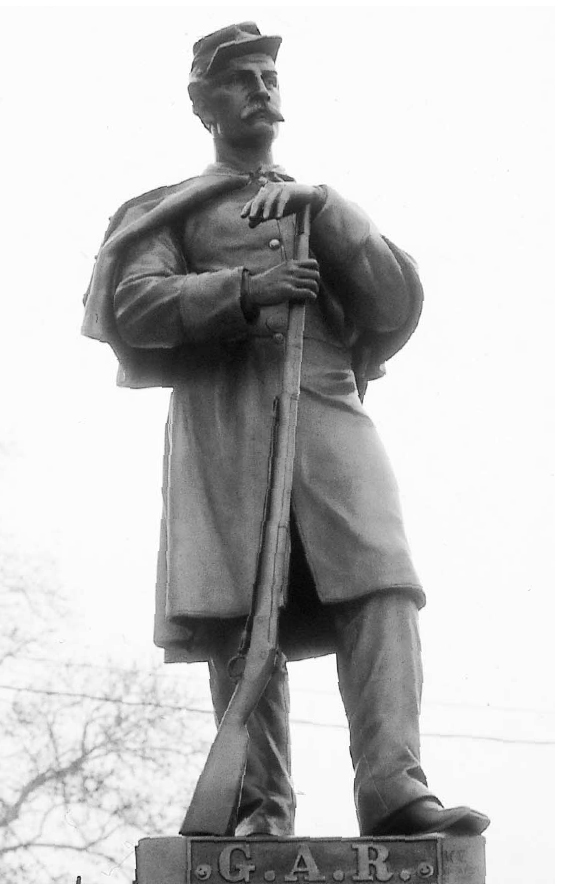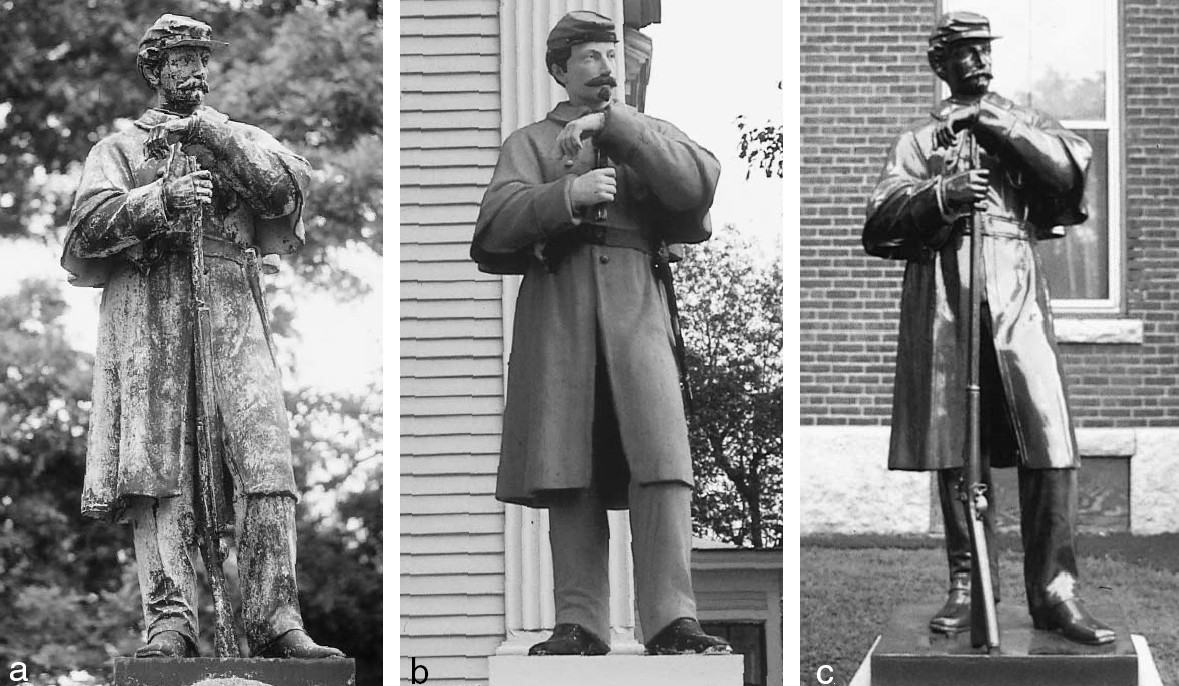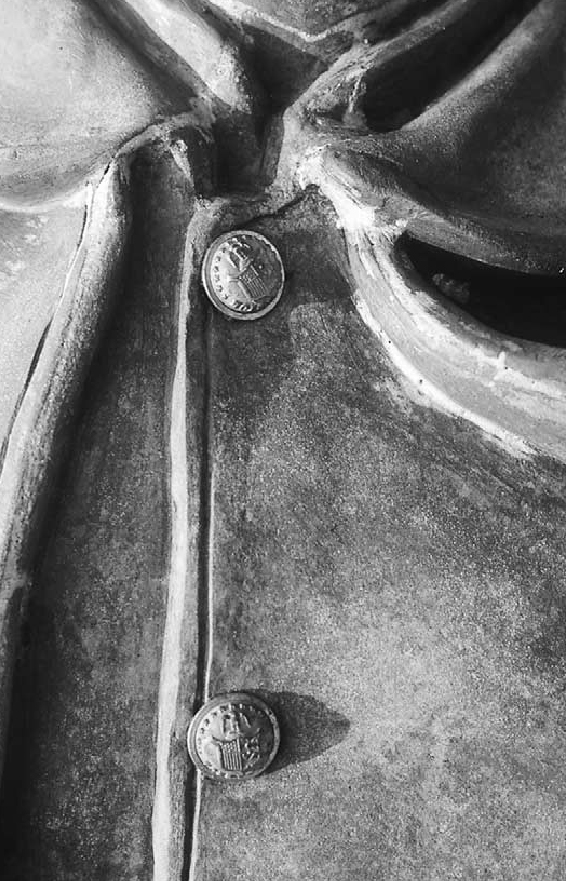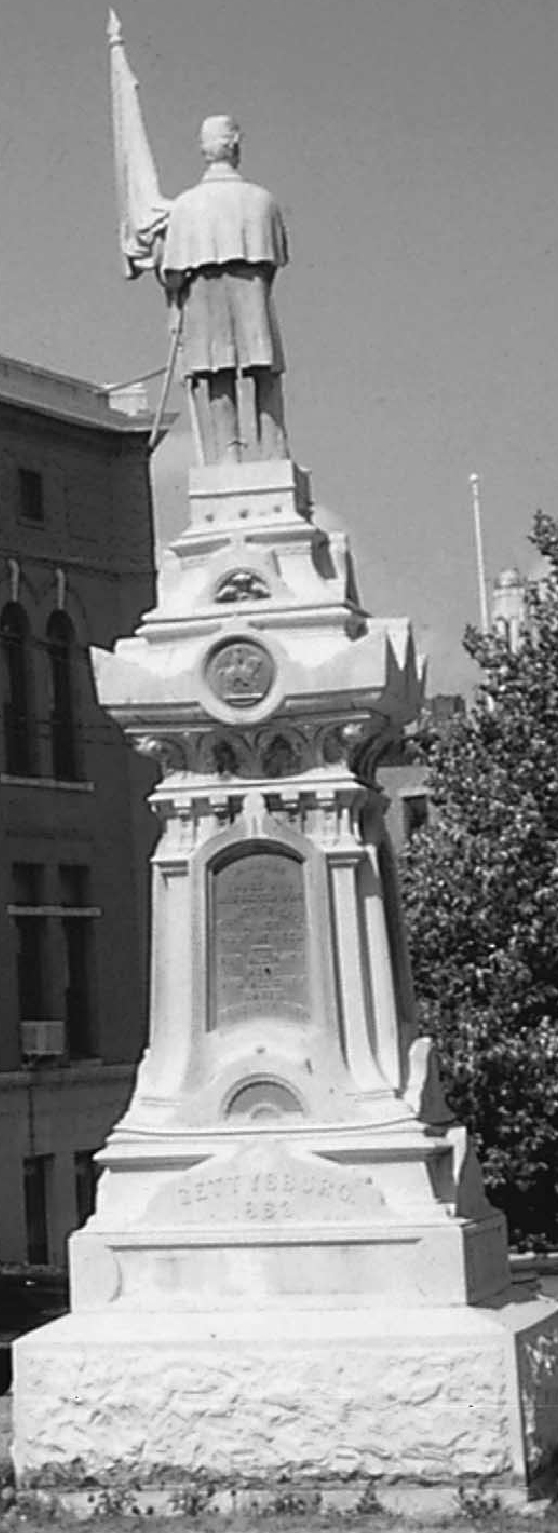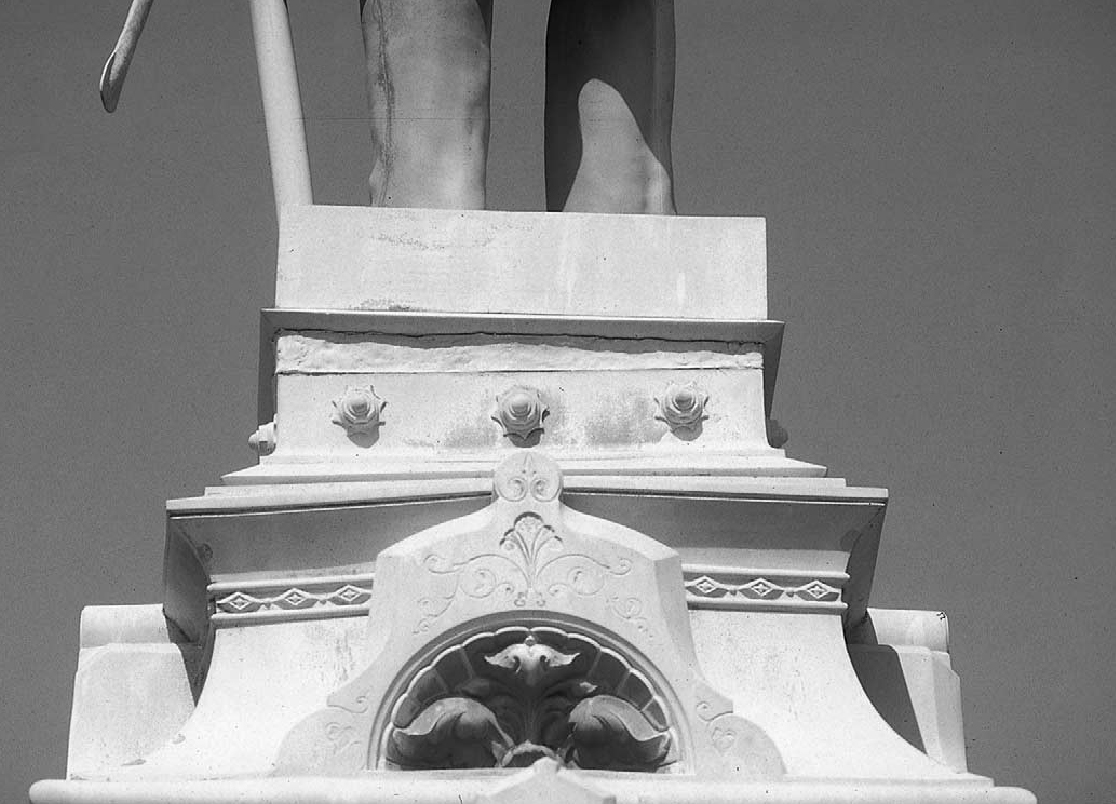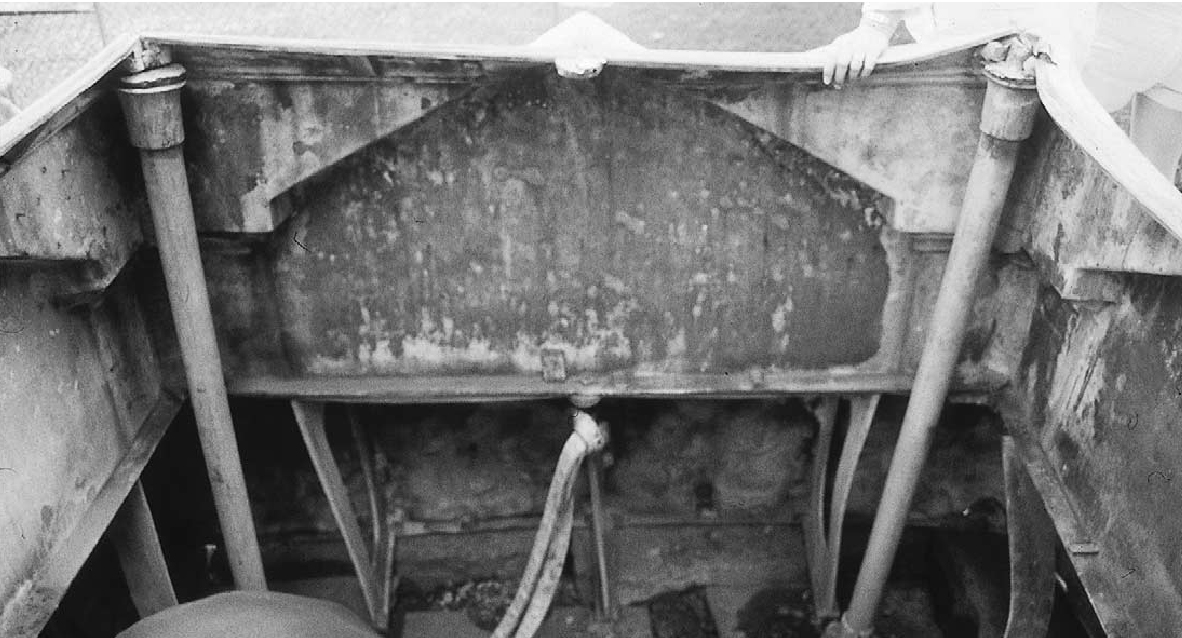THE CONSERVATION OF AMERICAN WAR MEMORIALS MADE OF ZINCCAROL A. GRISSOM, & RONALD S. HARVEY
2 FABRICATIONThe principal advantage of using zinc for monuments was that this dull, gray metal could inexpensively be made to imitate bronze or stone. Application of paint or other surface treatments, however, made zinc an “invisible” metal. Today zinc remains almost unknown to the general public and even to conservation professionals. Zinc statues are frequently misidentified as lead or cast iron since all three are “white” metals. In fact, lead can be readily differentiated because it is easily scratched, and iron can be distinguished because it is magnetic. Cast iron was zinc's chief competitor for low-cost statuary in America. At first, zinc fountain statues like Antonio Canova's (1757–1822) Hebe, first produced in marble in 1796, probably copied cast-iron statues made slightly earlier by companies like the Philadelphia firm of Robert Wood & Company (Hinckley 1853). Use of zinc for fountain statues quickly superseded cast iron, however, because zinc was so easily cast and joined with ordinary lead-tin solder. Before the development of welding at the end of the 19th century, cast-iron statues had to be laboriously made by bolting pieces together; alternatively, they could be cast whole, which required complex molding or pattern making. Cast iron remained in use for statuary only when its advantages of weight and strength were important. For instance, Jockey, Chinaman, and Darkey hitching posts were made exclusively of cast iron. Identical statues cast in zinc had more limited uses as trade signs for stables and teahouses, as well as for the New York City premises of the statue's purveyor, J. W. Fiske (Fried 1970). Cast-iron animal statues also may have continued to outnumber their zinc counterparts because their ruggedness made them more suitable for display on lawns. American zinc statues were fabricated using three techniques. The most common was to assemble small sand-cast pieces with lead-tin solder. Surfaces of soldiers fabricated in this way were almost invariably painted to simulate bronze. A second type of statue was described by its producers as made of so-called white bronze, a material distinct from real (copper alloy) bronze. White bronze was produced only by the Monumental Bronze Company in Bridgeport, Connecticut, or affiliates with similar names and mostly used for tombstones and cemetery statues. White-bronze statues were carefully made so that joins were unobtrusive, and surfaces were sandblasted to achieve matte finishes that had the “appearance of a superior sort of stone” (Schuyler 1878, 7). A third technique, stamping statues in sheet zinc, was used mostly for architectural statues. These could be purchased for even less than cast statues. Only one sheet-zinc soldier has been located, however, probably because identical soldiers made from sheet copper could be purchased for only a little more money. Supporting armatures are always found inside sheet-zinc statues, while they are rarely used inside those made of cast zinc. 2.1 PAINTED CAST-ZINC STATUESContemporaneous publications describing fabrication of painted cast-zinc statues in America are almost nonexistent. The archives and recollections of The earliest known zinc soldiers were made for the City of New York Civil War Monument (1869) in Brooklyn's Green-Wood Cemetery: an Infantryman (fig. 1), Cavalryman, Artilleryman, and Engineer. Contemporaneous photographs and remnants of copper plating provide solid evidence that the statues originally imitated bronze (Richman 1998). Moreover, the statues are replicas of four bronze statues on an earlier City of New York Civil War Monument (1866) at Calvary Cemetery in Queens. While no further copies of three statues are known, the Infantryman was a popular figure standing at parade rest, wearing a greatcoat, and steadying his rifle with the fingers of his left hand dangling over the end of the barrel. The statue was reproduced at least once in zinc (for White Plains, New York) and four times in bronze (for Wilmington, North Carolina; Ossining, New York; and Clinton, and Lawrence, Massachusetts). It also seems to have been the model for two slightly different versions sold through trade catalogs in later decades (see below). M. J. Power (1836–1902) cast the bronze statues for the City of New York Monument in Calvary Cemetery, and later bronze copies of the Infantryman bear his foundry mark. The founder for the zinc statues at Green-Wood Cemetery is undocumented, but Seelig is the most likely candidate. During the 1850s the immigrant sculptor had established a zinc foundry in Williamsburg, just across the East River from New York City, and verbal tradition among his descendants supports attribution of the soldiers to his foundry (Sammel 2002). The sculptor is unknown, but the statues bear considerable resemblance to the work of Buberl. Moreover, Buberl is known to have worked with Power and modeled several zinc statues cast by Seelig, including a colossal Robert Fulton (1872) for the Fulton Ferry landing in Brooklyn, now in the Museum of the City of New York. Recent bronze replication afforded an opportunity for close examination of the Green-Wood Cemetery statues at Modern Art Foundry in Queens, New York. During deinstallation at the cemetery, the
In subsequent decades, slightly different versions of the Green-Wood Cemetery's Infantryman were sold through catalogs by J. W. Fiske and the J. L. Mott Iron Works, known in about 10 copies each. Principally purveyors of utilitarian ironwork, the two New York City companies had sidelines in fountains with cast-iron basins that incorporated zinc statues, and they marketed individual zinc statues as well. Both companies seem to have obtained statues from a zinc foundry, which cast their models, sold them statues “off the shelf,” or both. J. W. Fiske used M. J. Seelig & Co. for casting statues by 1892 (Seelig 1892; Fiske 2000), and in 1927 Seelig scrapped Fiske's patterns for the Civil War Soldier on the company's behalf (Seelig 1927). No documentation has been found regarding Mott's source for zinc statues, but nearly all statues in a Mott catalog of 1873 are listed in a contemporaneous Seelig catalog (1876), supporting the Seelig foundry as the source during those years. J. W. Fiske's soldier (fig. 2) was almost certainly modeled before the Mott statue, since the 1875 dedication of a copy in Saratoga, New York, is well documented. The name of the statue's modeler—Allicot—has been found in Fiske family papers (Fiske 1941) and can be plausibly identified with Henry J. Ellicott (1848–1901) since the statue resembles other works by the sculptor, e.g., the First Pennsylvania Cavalry Monument (1890) at Gettysburg. The figure
J. W. Fiske's statues were mainly cast in sand using zinc patterns, which could be used an almost unlimited number of times (Wilkinson 1871). Cast-iron piece molds were also made for slush-casting portions of Fiske's statues, such as a small head, although there is no evidence of this form of manufacture in the case of Fiske's soldier (Fiske 2000). The patternmaker placed seams where it was convenient for molding and casting instead of where they would be unobtrusive, since statues were to be painted. From the 1930s until zinc statues were no longer sold by the company in the 1950s, cast pieces arrived from the foundry at Fiske's Manhattan offices packed in burlap bags inside wooden barrels (Fiske 2000). There, facilitated by marks that had been struck across joins on interior surfaces of the patterns, they were soldered together by workmen in the subbasement. Mott's statues are similar to those of Fiske in terms of fabrication, and soldiers sold by both companies were customized with genuine gilt-brass army buttons soldered to the zinc. Presumably obtained by the foundry from those available in New York City, buttons on a J. W. Fiske statue in Pottstown (fig. 4) are those of New York state militia rather than the local Pennsylvania regiment (Albert 1976). Both Mott and Fiske soldiers were available “painted one coat” (probably a primer) or, for a slightly higher price, “bronzed” (Mott 1890, 1901, 1911; Fiske ca. 1908–15). According to 19th-century documents, Fiske sent a workman to “bronze” a fountain on-site in the New York area (Fiske 1893), and analyses have shown that this treatment consisted of the successive application of white lead paint, reddish brown paint, and copper flakes in a clear medium, topped by varnish (Grissom 1994). Microscopic examination of original bronze paint from the Pottstown soldier revealed three layers, with the middle layer containing copper flakes dusted on still-wet lacquer (Lins 1996). From at least the 1930s through the 1950s, statues were painted in Fiske's
2.2 WHITE-BRONZE MONUMENTSWhite-bronze monuments and statues were sold only by the Monumental Bronze Company; its predecessor, Schuyler, Parsons, Landon, & Co.; and affiliates: the Detroit White Bronze Company; the Philadelphia White Bronze Company; the American Bronze Company in Chicago; the Western White Bronze Company in Des Moines, Iowa; and the St. Thomas White Bronze Company in St. Thomas, Ontario (Rotundo 1989). White bronze was promoted as the latest scientific achievement, and articles about it appeared in contemporary scientific journals (Scientific American 1885; Saw 1910). Considerable documentation of the companies' unique fabrication processes is also provided in advertising (Schuyler 1878; Monumental Bronze 1882; American Bronze ca. 1891; Western White Bronze 1893). The following is taken from the American Bronze Company (ca. 1891, 9) catalog:
Joining zinc with zinc is unusual, not otherwise done in the United States or Europe. Molten zinc does not adhere well to cast zinc, and the deposits of molten metal had to be quite thick in order for pieces to be successfully joined. Sometimes the strategy seems to have been to key pieces in place mechanically. During treatment at Modern Art Foundry, for instance, a Confederate soldier from Suffolk, Virginia, was found to have 20 cm of solid metal inside the lower legs, apparently for attaching it to the base. The underside of the base revealed that a cast-zinc bar had By far the most popular white-bronze statue was referred to in the Monumental Bronze Company's catalog as an American Soldier, depicted standing at parade rest but now with both hands around the barrel of his rifle (fig. 5). More than 60 Union and 2 Confederate white-bronze copies of the American Soldier were erected between 1877 and 1913. The statue is an awkward version of bronze soldiers available shortly after the end of the Civil War, including those by Martin Milmore (1844–1881) in New England towns, Randolph Roger's (1825–1892) Infantryman for the Michigan Soldiers' and Sailors Monument in Detroit (1867), and J. Q. A. Ward's (1830–1910) Seventh Regiment Memorial (1869) placed in New York's newly created Central Park. Somewhat less popular was a white-bronze statue of a Colorbearer holding onto the staff of a large upright flag with his left hand, a drawn sword in the other hand. It is known in 11 copies dedicated from 1886 to 1908 (figs. 6, 7). Since white bronze appears bluish
One of the most unusual aspects of white-bronze Civil War statues is that more than half were displayed atop imitation-stone bases also made of white bronze (see figs. 5, 6). In some cases this combination resulted in monuments more than 12 meters in height. The use of zinc for such large structures is unique. Nothing this ambitious was attempted in Europe, although zinc was used more extensively in Central Europe for both statuary and architecture. These white-bronze bases consist of three to six sections, each square in plan, including columns, Corinthian capitals, and sections customized with inscriptions or low-relief illustrations. The lowest section almost invariably was modeled in imitation of rough-hewn rock, sometimes with a foundry inscription in raised letters on the back face. Each section was made by fusing the corners of its four sides with thick deposits of zinc. Sections were kept separate for easy transport and assembly on-site. Typically, white-bronze monuments were placed without attachment on simple footings. Sometimes these consisted of as little as a single course of stone placed on the ground. Starting from the bottom, as sections were added, each was bolted to the adjacent section on the inside center of each face. The final step was to place the statue on top. It was usually attached on center through the self-base, using brass bolts covered by decorative white-bronze heads. Original supports are minimal inside all large white-bronze monuments that have been examined (fig. 8). Several vertical cast-zinc stiffener plates were attached at the foundry inside each face of the lowest
2.3 SHEET-ZINC SOLDIERSStamped sheet-zinc statues are readily distinguished from cast statues by their thinness, light weight, smooth surfaces, and susceptibility to denting. Identical models were available stamped in zinc, copper, brass, or bronze sheet through trade catalogs that featured architectural metalwork. The earliest known model of a sheet-metal soldier, a Soldier on Guard, appeared in a Bakewell & Mullins catalog in 1887. By 1897, eight soldiers are found in a catalog of the Friedley & Voshardt Company. Many models are almost exact copies of earlier cast-zinc statues, including the Green-Wood Cemetery–type Infantryman and white-bronze statues of the American Soldier and Colorbearer. While extant sheet-copper or sheet-bronze soldiers are relatively common, only one sheet-zinc soldier has been located, a W. H. Mullins Company (1913)Confederate Infrantryman at Parade Rest on the Confederate Monument (1891) in Georgetown, South Carolina. Two sheet-zinc statues in Paducah, Kentucky, are known as The Blue and The Gray but were actually sold by the Friedley & Voshardt Company as School Boys. By 1896, statues stamped from copper-alloy sheets cost little more than zinc (Mullins 1896), and in 1913, when the W. H. Mullins Company issued a beautifully bound catalog of sheet-metal soldiers for the 50th anniversary of the Gettysburg battle, only sheet-copper and bronze statues are illustrated. At the most active architectural sheet-metal company, W. H. Mullins, dies for stamping were made from plaster models. The lower die was made of cast zinc, and the upper die of lead. Sheet metal was heated, then placed between the dies and smashed into shape with a drop hammer (Lemonte 1947). The stamped pieces were then riveted or soldered
|
